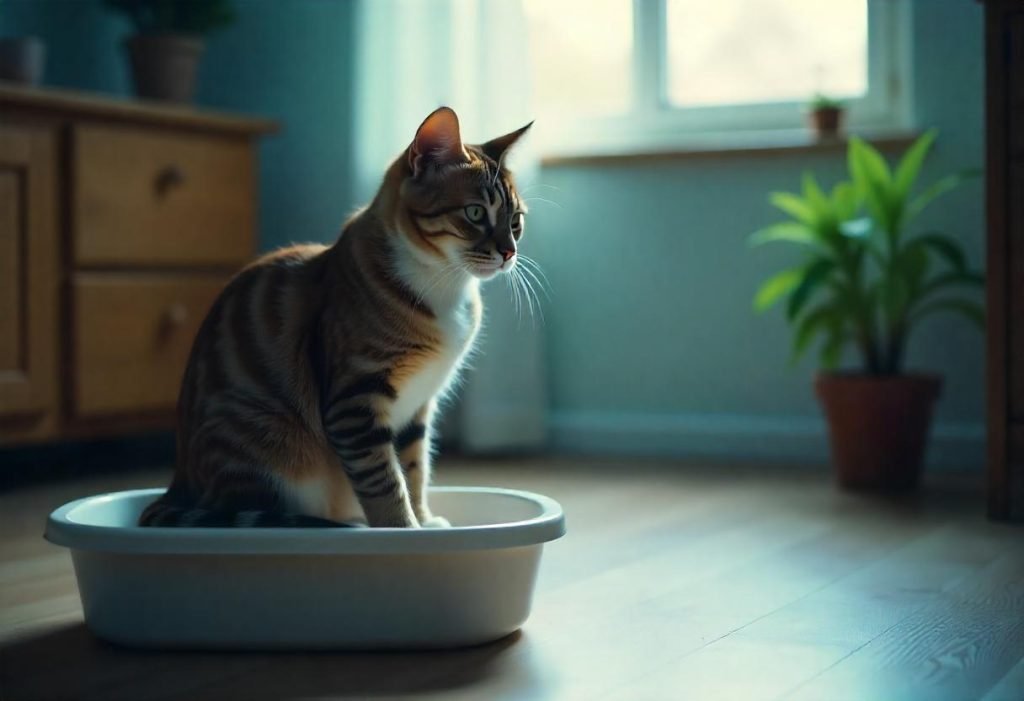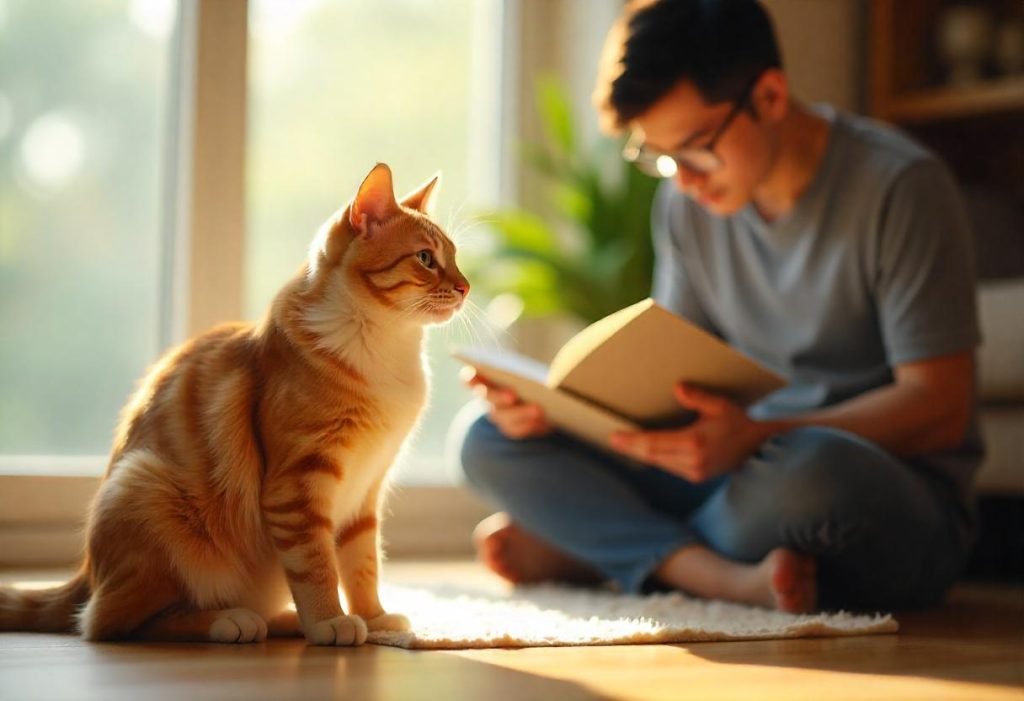The sight of your cat frequently using the litter box, particularly when they’re peeing more than usual, can be a cause for concern and you may think why is my cat peeing a lot.
While cats are known for their meticulous bathroom habits, excessive urination, also known as urinary frequency, can be a sign of various underlying issues.
This article delves into the world of feline urinary problems, exploring the diverse range of causes, offering insights into potential complications, and guiding you towards effective solutions.
We’ll break down complex medical jargon into easy-to-understand language, using real-life case studies to illustrate the journey towards a happy, healthy, and litter box-loving kitty.
Understanding Urinary Frequency in Cats: A Deeper Look
Imagine a constant need to urinate, a feeling of urgency, and even pain with each trip to the bathroom.
This is the experience your cat might be enduring if they’re peeing excessively. Understanding the potential causes of urinary frequency in cats is crucial to address the problem effectively.
1. Urinary Tract Infections (UTIs): A Common Culprit
Just like humans, cats can develop infections in their urinary tract, which can cause increased urination, pain, and discomfort.
- Symptoms: Frequent urination, straining to urinate, blood in the urine, and a strong odor in the urine.
- Causes: Bacteria, often from the gut, can travel to the urinary tract and cause an infection.
- Diagnosis: Urine analysis to identify bacteria and inflammation.
- Treatment: Antibiotics to treat the infection.
Case Study: Charlie’s Uncomfortable Bathroom Trips
Charlie, a 5-year-old tabby, started peeing more frequently and was straining to urinate.
His veterinarian diagnosed a urinary tract infection and prescribed antibiotics. After a week of treatment, Charlie’s symptoms resolved, and his urination returned to normal.

2. Feline Lower Urinary Tract Disease (FLUTD): A Complex Condition
FLUTD, a general term for various conditions affecting the bladder and urethra, can lead to urinary frequency, as well as other problems like straining to urinate, blood in the urine, and even blockage.
- Types:
- Feline Idiopathic Cystitis (FIC): An inflammation of the bladder of unknown cause, often linked to stress or anxiety.
- Urinary stones (urolithiasis): Crystals that form in the bladder or urethra can block the flow of urine, causing discomfort and pain.
- Tumors: Cancers in the bladder or urethra can cause various urinary problems, including increased frequency.
- Symptoms: Frequent urination, straining to urinate, blood in the urine, and a strong odor in the urine.
- Diagnosis: Urinalysis, blood tests, and imaging studies, such as ultrasound or X-rays, to identify the specific cause.
- Treatment: Depends on the underlying cause, ranging from medication to manage inflammation to surgery to remove stones or tumors.
Case Study: Lily’s Stress-Related Bladder Issues
Lily, a 7-year-old Persian, was peeing more frequently and straining to urinate.
Her veterinarian diagnosed Feline Idiopathic Cystitis (FIC) and prescribed medication to reduce inflammation.
With environmental enrichment and stress management techniques, Lily’s symptoms improved, and her urinary frequency decreased.
3. Diabetes: A Hormonal Imbalance
Diabetes, a condition where the body cannot regulate blood sugar properly, can lead to increased urination, as well as other symptoms like increased thirst, weight loss, and lethargy.
- Symptoms: Frequent urination, increased thirst, weight loss, lethargy, and increased appetite.
- Diagnosis: Blood tests to measure blood sugar levels.
- Treatment: Insulin therapy to regulate blood sugar levels.
Case Study: Max’s Thirst and Frequent Urination
Max, a 9-year-old Siamese, was drinking excessively and peeing more frequently. His veterinarian diagnosed diabetes and prescribed insulin therapy.
With proper management, Max’s symptoms improved, and his urination returned to normal.

4. Kidney Disease: A Filter Failure
Kidney disease, where the kidneys fail to filter waste products effectively, can lead to increased urination, as well as other symptoms like increased thirst, lethargy, and loss of appetite.
- Symptoms: Frequent urination, increased thirst, lethargy, loss of appetite, and vomiting.
- Diagnosis: Blood tests and urine analysis to assess kidney function.
- Treatment: Dietary changes, medication, and fluid therapy to manage kidney disease.
Case Study: Oliver’s Thirst and Frequent Urination
Oliver, a 12-year-old tabby, was drinking and peeing excessively.
His veterinarian diagnosed chronic kidney disease and prescribed dietary changes and medications. With proper management, Oliver’s urination frequency decreased, and his condition stabilized.
5. Hyperthyroidism: A Hormone Imbalance
Hyperthyroidism, an overactive thyroid gland, can cause increased urination, as well as other symptoms like weight loss, increased appetite, and increased thirst.
- Symptoms: Frequent urination, increased thirst, weight loss, increased appetite, and lethargy.
- Diagnosis: Blood tests to measure thyroid hormone levels.
- Treatment: Medication to regulate thyroid hormone levels.
Case Study: Bella’s Increased Thirst and Urination
Bella, an 8-year-old Siamese, was drinking and peeing more frequently and had lost weight.
Her veterinarian diagnosed hyperthyroidism and prescribed medication. With proper management, Bella’s urination frequency decreased, and her condition improved.
6. Medications: A Potential Side Effect
Some medications, like diuretics, can cause increased urination as a side effect.
- Symptoms: Frequent urination.
- Diagnosis: Review of your cat’s medication history.
- Treatment: Adjusting or discontinuing the medication, if possible.
Case Study: Charlie’s Medication-Induced Frequent Urination
Charlie, a 6-year-old tabby, was prescribed a diuretic medication for a heart condition.
He started peeing more frequently. His veterinarian adjusted the medication dosage, and Charlie’s urination frequency decreased.
7. Behavioral Factors: A Psychological Perspective
Stress, anxiety, and even fear can trigger an increase in urination frequency in cats.
- Symptoms: Frequent urination, especially when stressed or anxious.
- Causes: Changes in routine, new pets, moving to a new home, or even loud noises can trigger stress.
- Treatment: Creating a calm and comfortable environment, providing enrichment activities, and using calming pheromones can help reduce stress.
Case Study: Lily’s Stress-Related Urinary Frequency
Lily, a 4-year-old Persian, started peeing more frequently after her owner brought home a new puppy.
Her veterinarian diagnosed stress-related urination and recommended environmental enrichment and calming pheromones. With the help of these strategies, Lily’s urination frequency decreased, and her stress level reduced.
Decoding Your Cat’s Urinary Frequency: Seeking the Source
When you notice your cat peeing more frequently, it’s crucial to seek professional help to identify the underlying cause. Here’s how to approach the situation:
1. Observation: The Power of Careful Watching
- Urination patterns: Keep a detailed log of your cat’s urination frequency, noting any changes in the volume, color, or odor of their urine.
- Behavior: Observe your cat’s behavior, noting any signs of pain, straining to urinate, or changes in their usual habits.
- Environment: Consider any recent changes in your cat’s environment that could be causing stress or anxiety.
2. Veterinary Examination: Seeking Professional Guidance
- Physical examination: Your veterinarian will conduct a thorough physical exam, checking for any signs of illness or injury.
- Urinalysis: A urine sample will be examined for bacteria, blood, crystals, and other abnormalities.
- Blood tests: To assess kidney function, blood sugar levels, and thyroid hormone levels.
- Imaging studies: Ultrasound or X-rays can be used to visualize the bladder, urethra, and kidneys to identify any structural abnormalities or stones.
Treating Urinary Frequency: A Tailored Approach
Treating urinary frequency in cats depends on the underlying cause, and your veterinarian will create a personalized treatment plan for your feline friend.
- Antibiotics: For bacterial infections, antibiotics are used to eliminate the bacteria causing the infection.
- Medication: To manage inflammation, pain, and other symptoms, depending on the diagnosis.
- Dietary changes: A special diet, often lower in magnesium, can help prevent the formation of urinary stones.
- Fluid therapy: In cases of dehydration or kidney disease, fluid therapy is essential to maintain hydration.
- Surgery: To remove stones or tumors, if necessary.
- Stress management: Techniques like creating a calm environment, providing enrichment activities, and using calming pheromones can help reduce stress-induced urination.
Preventing Urinary Frequency: A Proactive Approach
While urinary frequency can be a concern, there are steps you can take to minimize the risk of your cat experiencing these issues.
- Regular veterinary checkups: Yearly checkups can help identify early signs of underlying conditions and prevent complications.
- Adequate hydration: Ensure your cat has access to fresh water at all times. Consider using a water fountain to encourage water intake.
- Stress management: Create a calm and comfortable environment for your cat, minimize disruptions, and provide enrichment activities like toys, scratching posts, and cat trees.
- Litter box hygiene: Keep the litter box clean and accessible to your cat. Use a litter that your cat prefers and ensure it’s scooped regularly.
- Dietary changes: Talk to your veterinarian about whether a specific diet is appropriate for your cat, particularly if they’re prone to urinary stones.
Conclusion: A Journey Towards a Healthy, Litter Box-Loving Cat
Witnessing your cat frequenting the litter box excessively can be worrisome.
Remember, understanding the root cause of your cat’s urinary frequency is crucial for effective treatment.
By observing your cat carefully, seeking professional help, and implementing appropriate management strategies, you can help your furry friend maintain a healthy, comfortable, and happy lifestyle.
Note: This article is for informational purposes only and should not be substituted for professional veterinary advice. Always consult with your veterinarian for a proper diagnosis and treatment plan for your cat’s specific needs.
